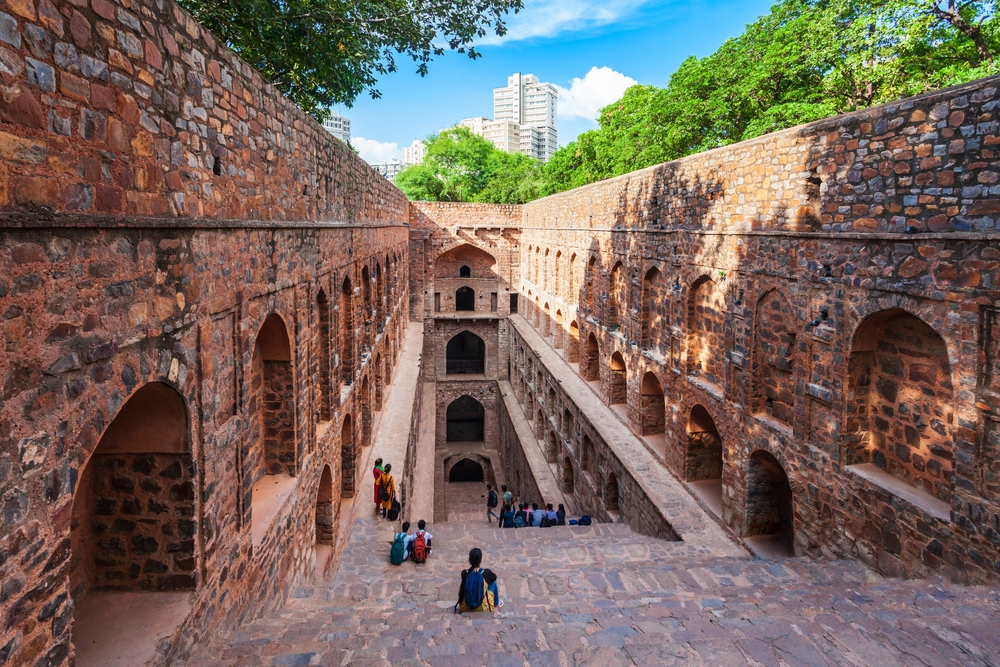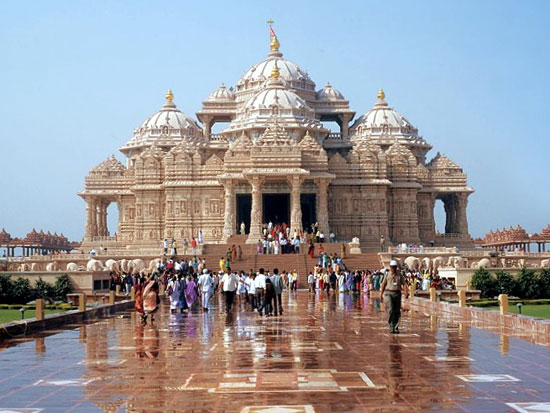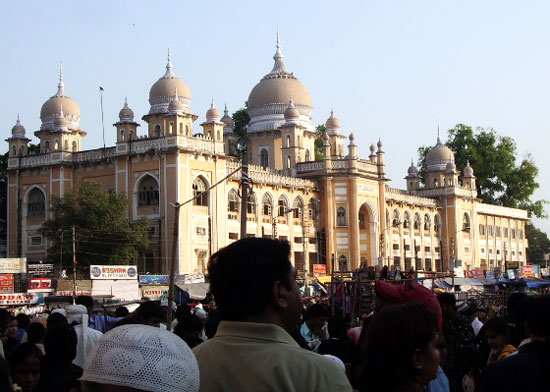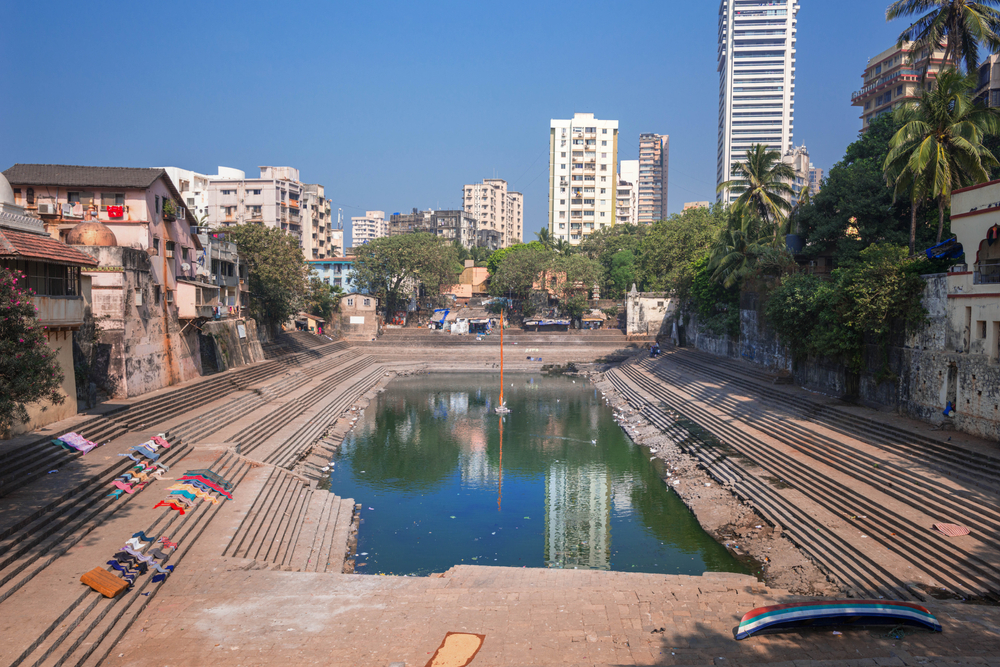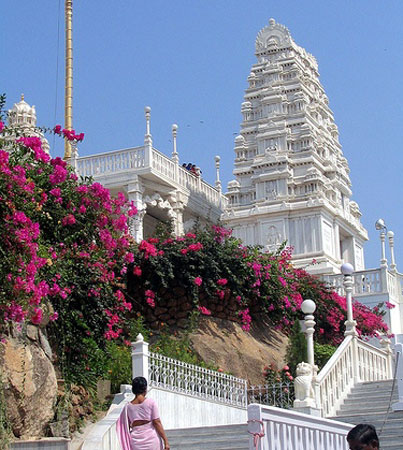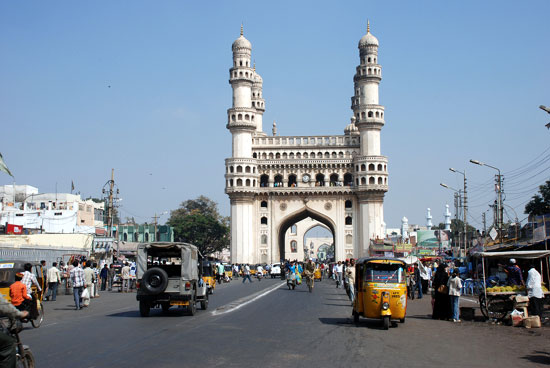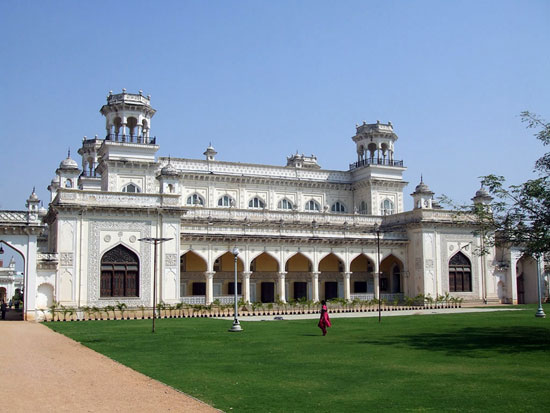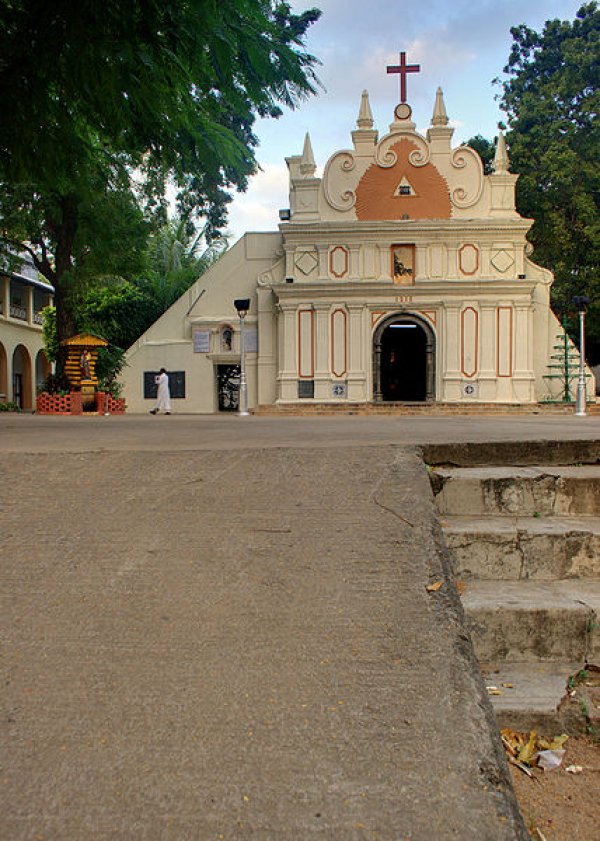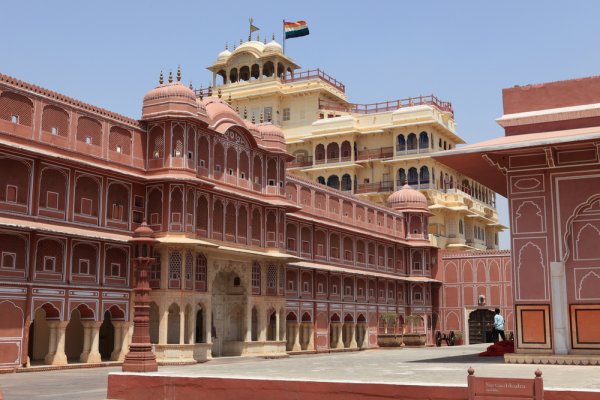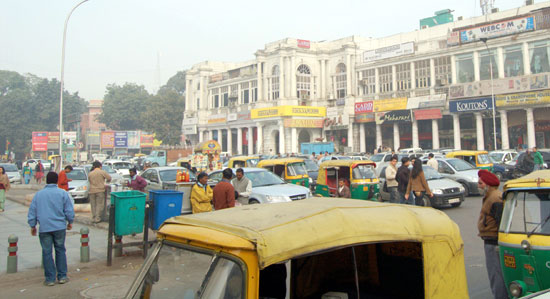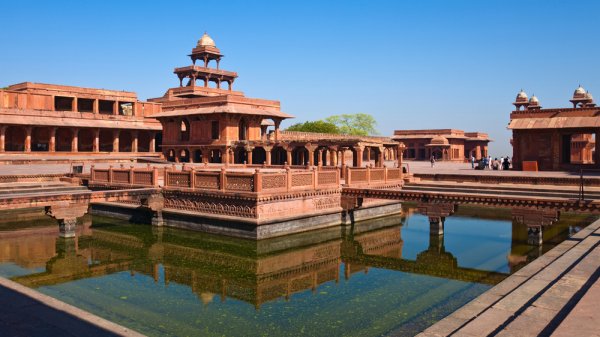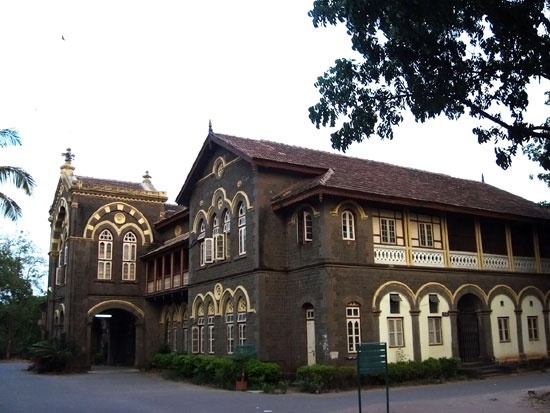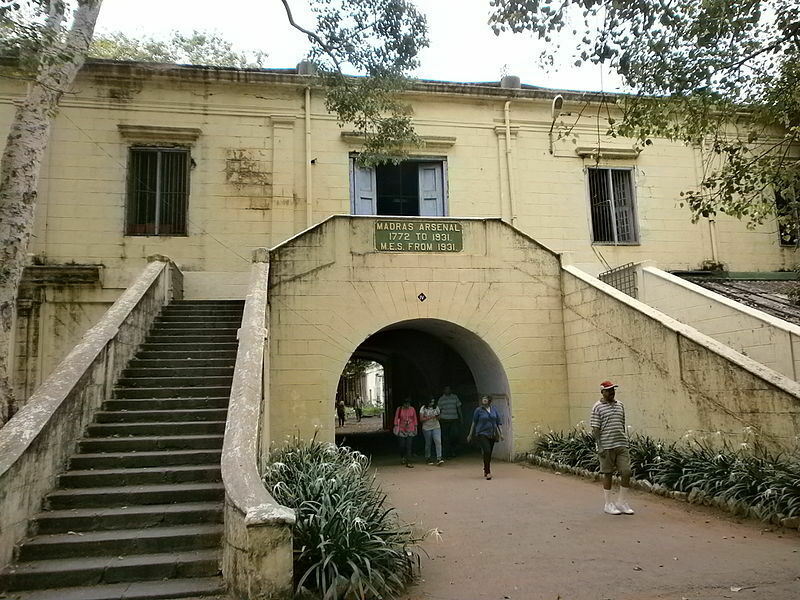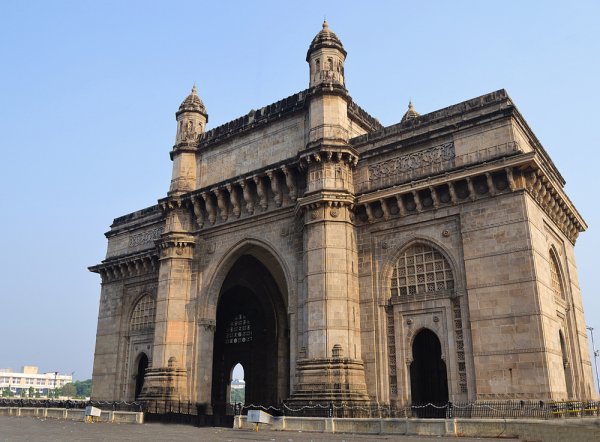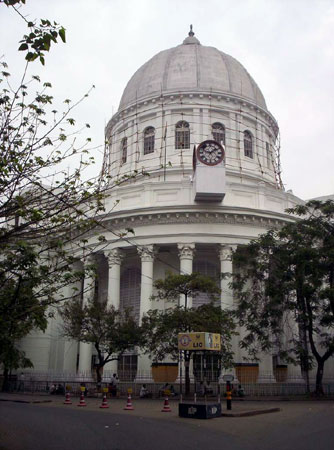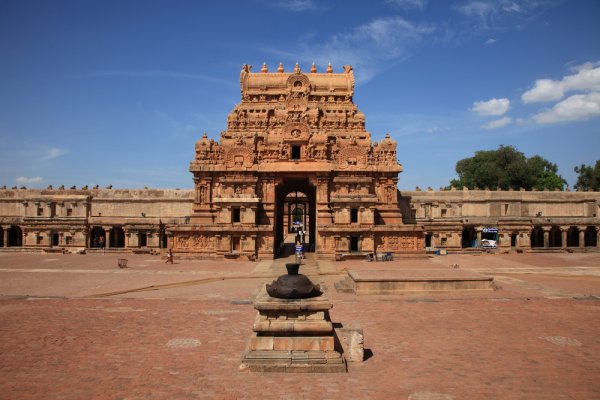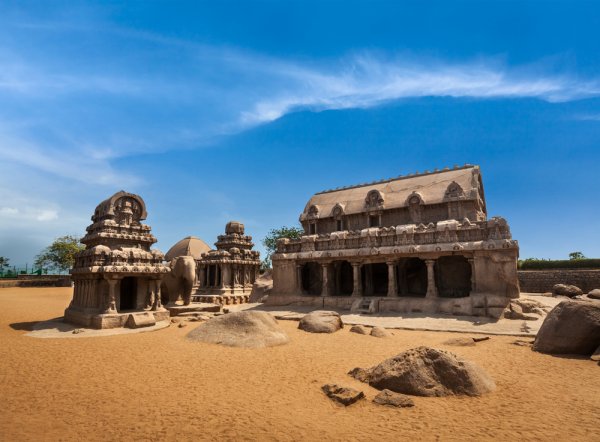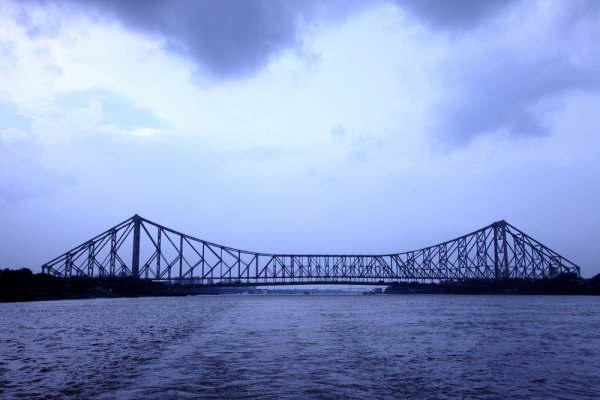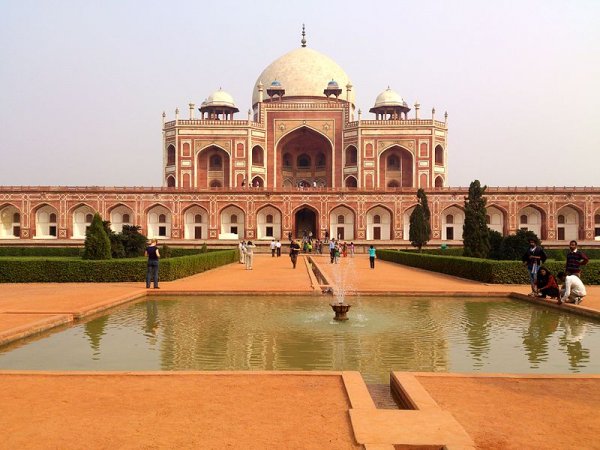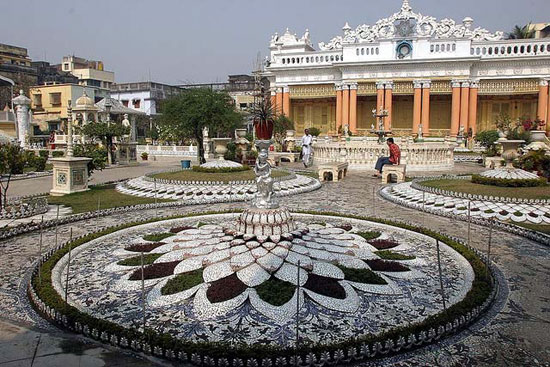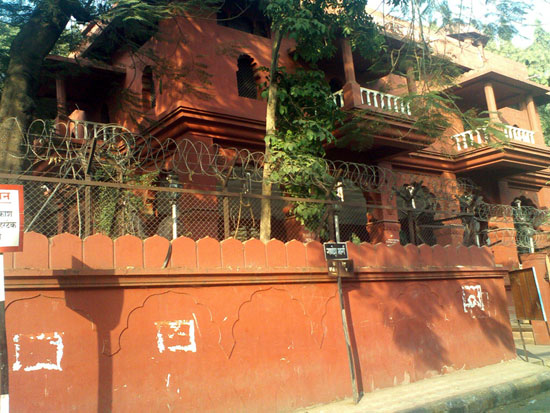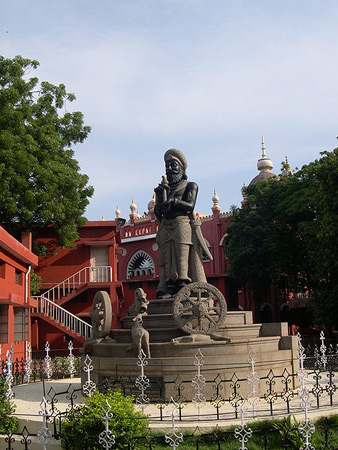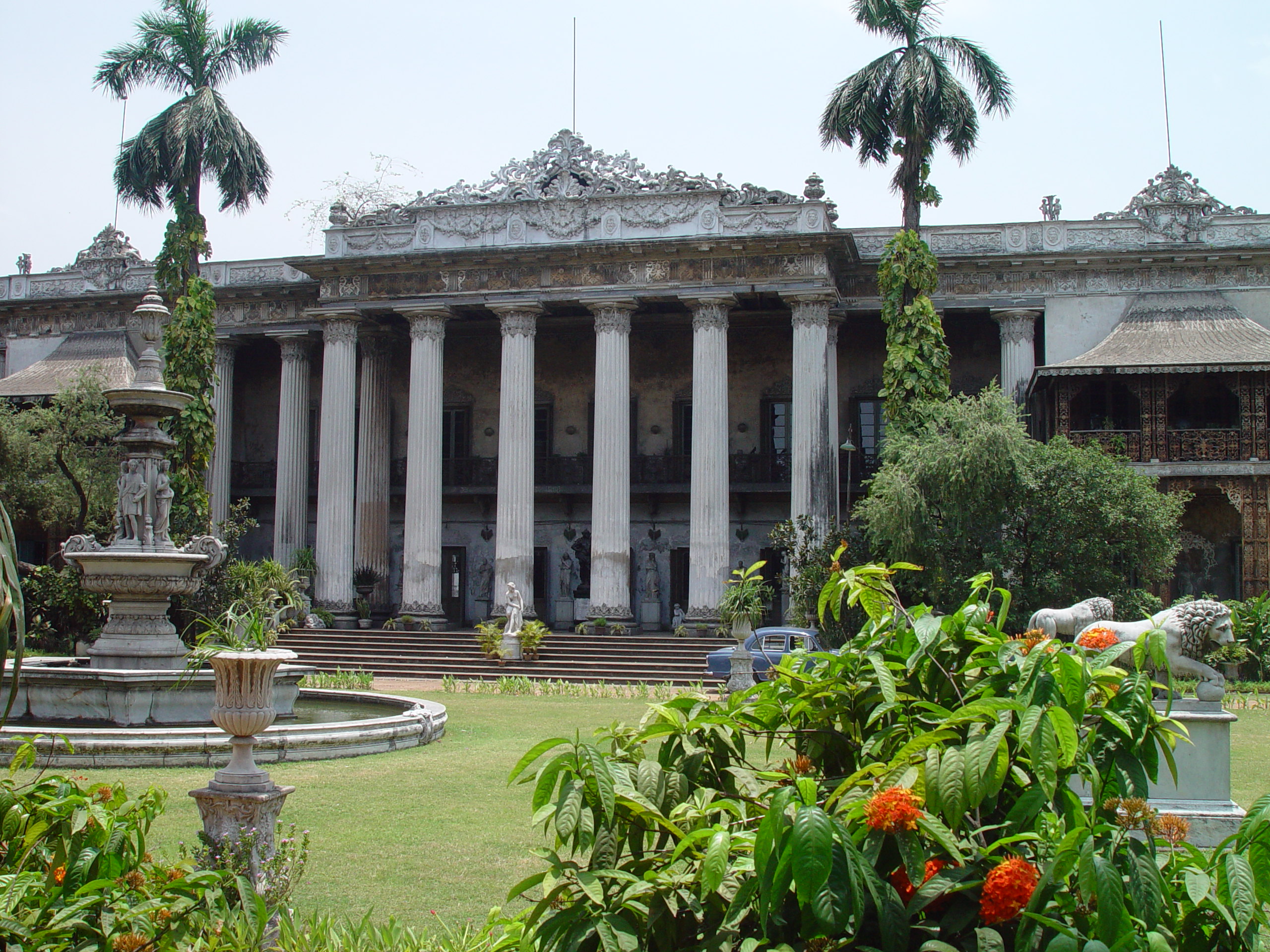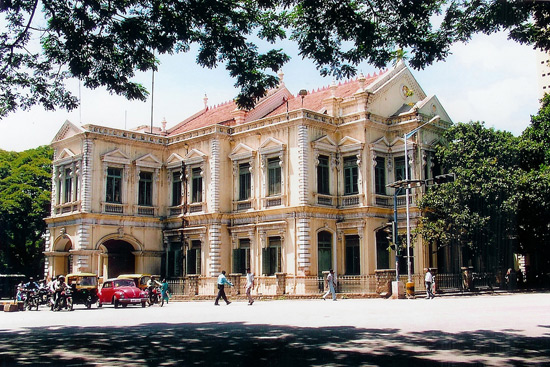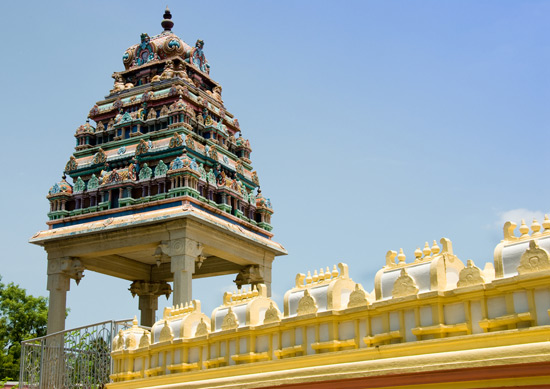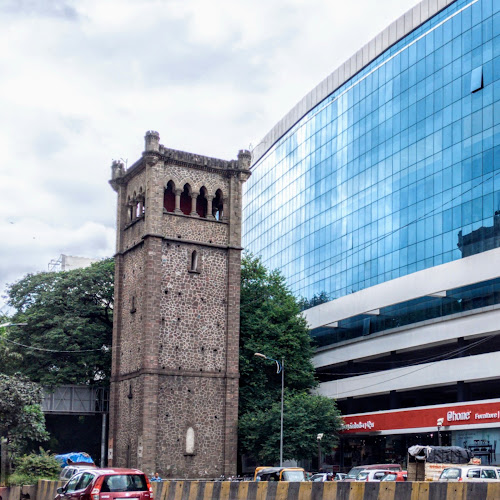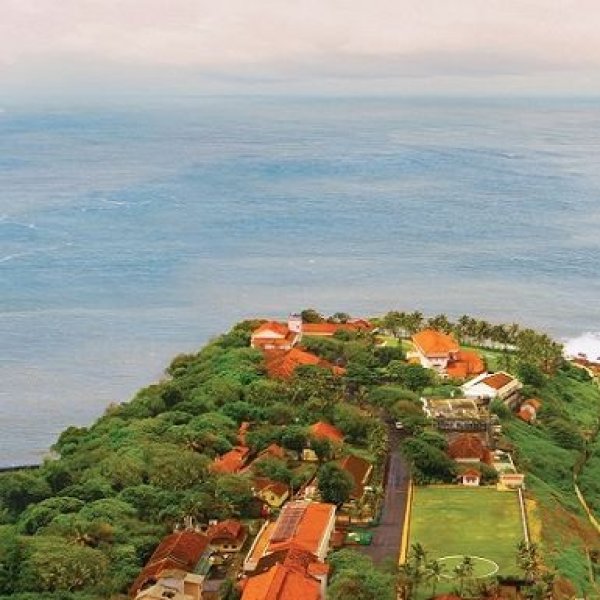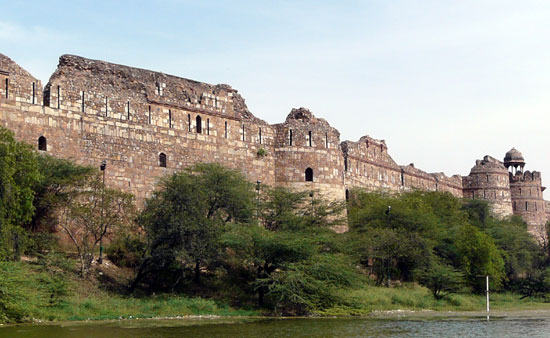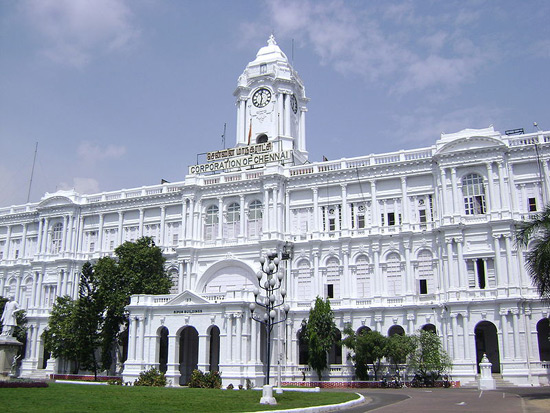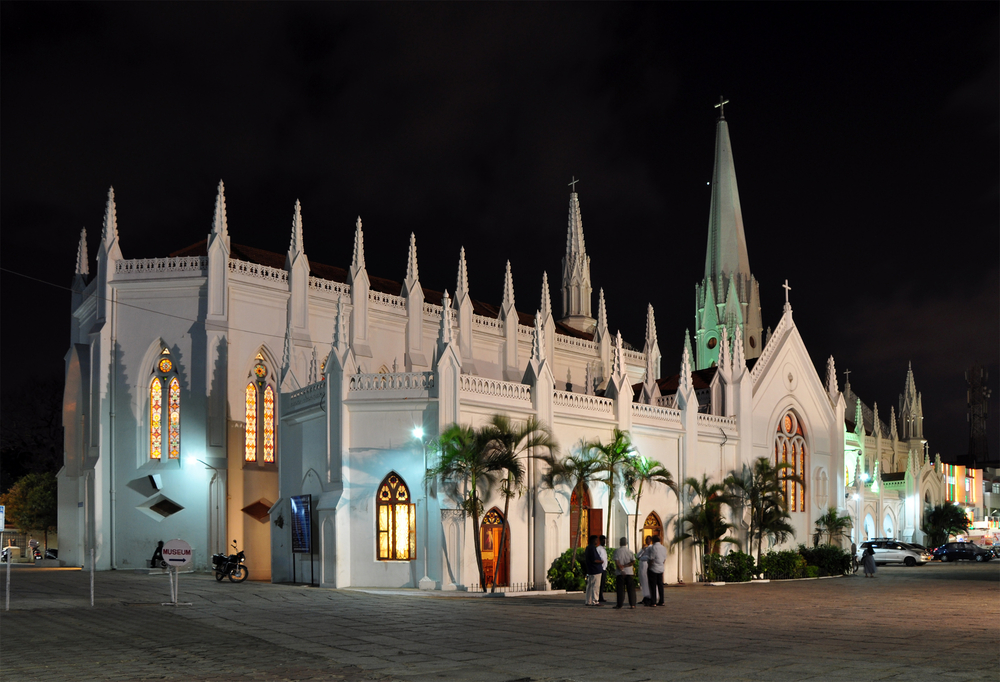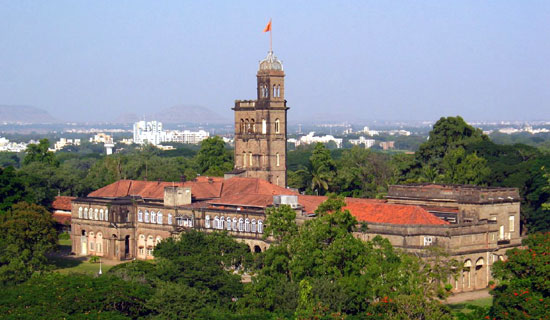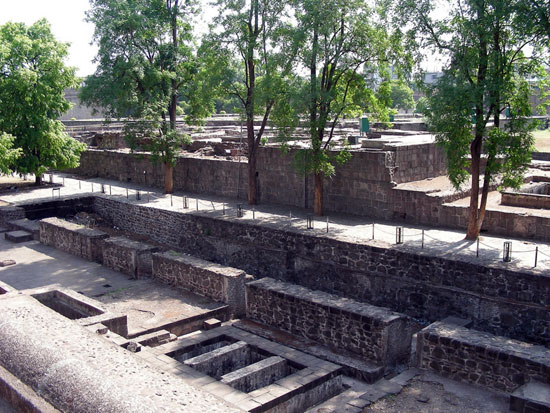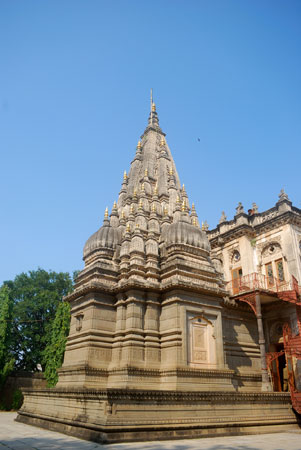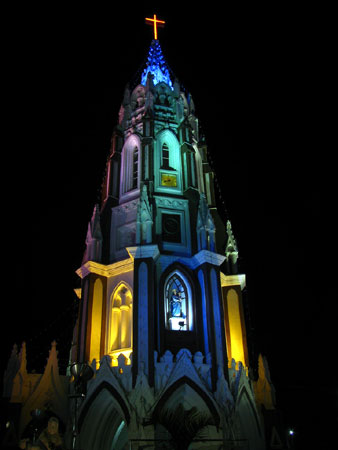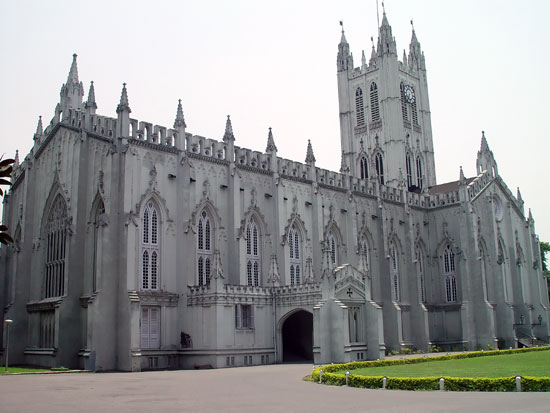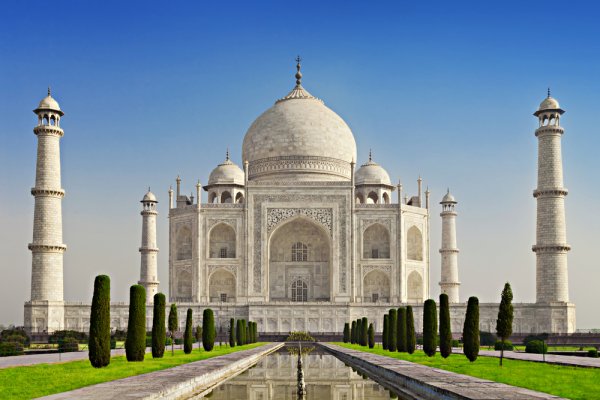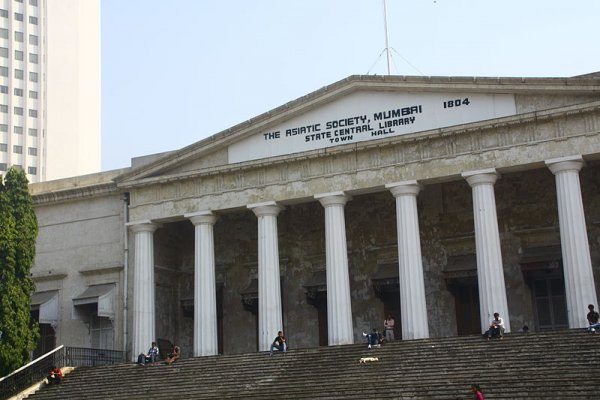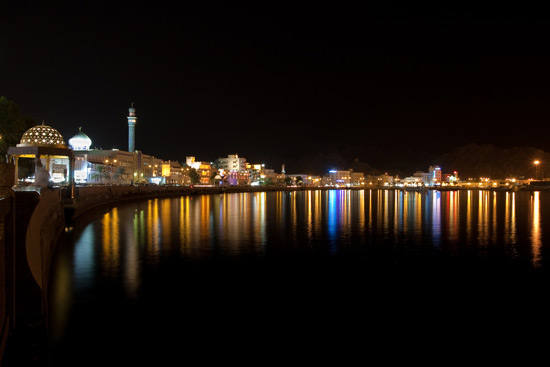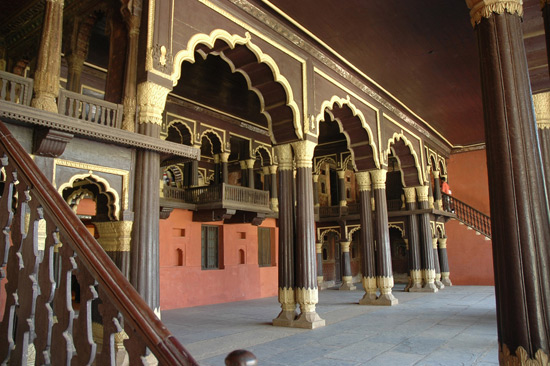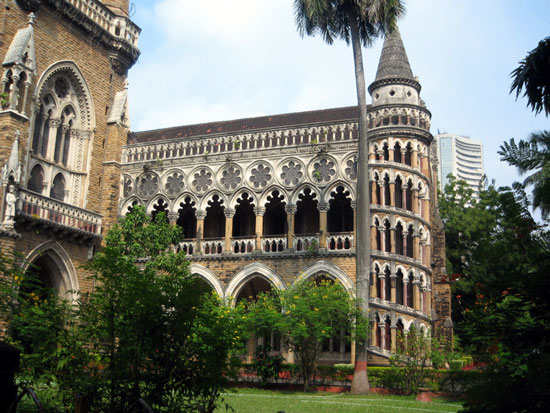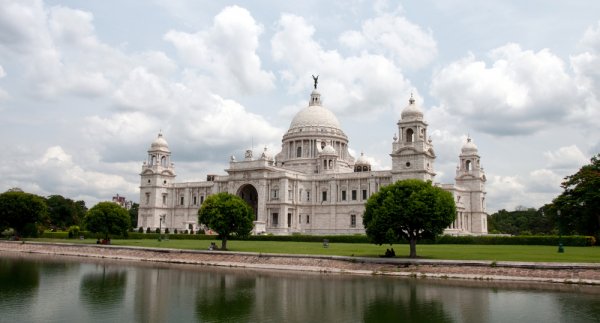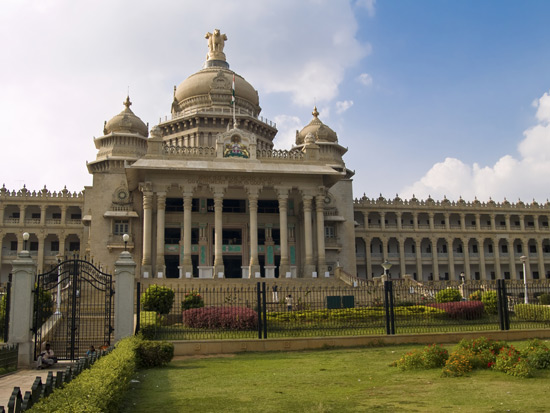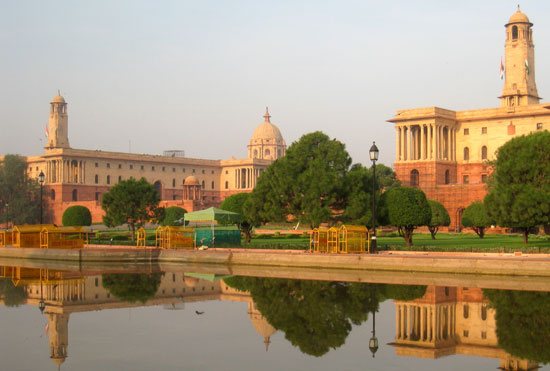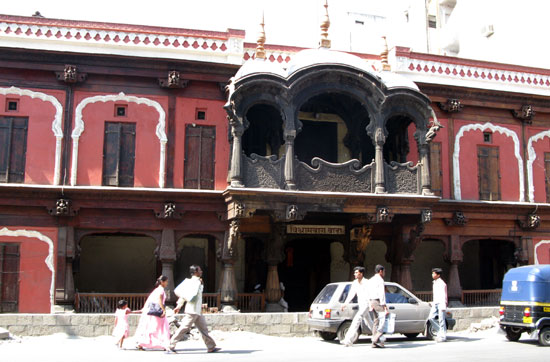Points of Interest
Agrasen ki Baoli
Hailey Road
New Delhi, India
Structures used to harvest water throughout India beginning around 600 CE were called baoli or vav, depending on the region. Also known as stepwells, they feature flights of steps leading underground to deep well shafts that ensured ground water could be reached year-round. Built around the late 14th and early 15th centuries, New Delhi’s Agrasen ki Baoli can be found behind a stone wall in one of the city’s busy commercial areas. It is supposedly named for a legendary king whose existence has never been proven. Today, the stepwell is considered one of New Delhi’s most haunted places.
Akshardham
National Highway 24, Near Noida Mor
New Delhi, India
Although many Delhi temples date back to the Moghuls, perhaps the most magnificent is a 21st-century construction. Akshardham, a spectacular example of traditional Indian temple architecture, was completed in 2005. Featuring 6,000 tons of pink sandstone from Rajasthan (along with a substantial amount of Italian Carrara marble), it was built by around 10,000 workers, 30 percent of whom were volunteers. Though the original cutting of the stone was done using machines, 7,000 carvers executed all the intricate details on the walls of the main monument, making this place of worship a blend of modern techniques and ancient skills. Spread out across its 40-hectare (100-acre) site on the east bank of the Yamuna River are a musical fountain, a boat ride, a stepwell, and 148 life-size stone elephants. On the temple's gates are sculpted 869 peacocks, India's national bird.
Andhra Pradesh High Court
Madina Razen Road
Hyderabad, India
Tourists can't enter this building, as it is the fully working High Court of Andhra Pradesh, but the façade alone is reason enough to come here. In 1916, architect Vincent Esch intended the pink and gold domes, sandstone portico, and pink granite to reflect both Moghul and European styles, and he did a fine job. A restoration project in the 1990s touched up the paintwork and blocked off the elegant verandas. Its environs-the swooning banyan and palm trees of Amin Bagh-couldn't be more romantic, and the nearby Afzal Ganj Bridge spices up a photo of the southern riverbank. Only since the 1950s has the High Court been the legal center of the state.
Ashtalakshmi Temple
Beach Road
Odaimanagar Besant Nagar, Chennai, India
The only temple in India featuring the eight manifestations of the goddess Mahalakshmi, this relatively new structure, built in 1976, nonetheless features various characteristics of traditional Dravidian temple architecture. The temple complex consists of a series of five tiers distinguished by intricate stone work painted in a multitude of colors. The second tier holds images of the principal deities, Mahalakshmi and Mahavishnu.
Badshahi Royal Ashurkhana
Mahboob Shahi Road
Hyderabad, India
The two key features of this traditional Muslim house of mourning are fine timber columns and intricate hexagonal mosaics, which surpass any mere description. These were added in the 18th century, long after the edifice was built in 1594 by the Nizam of the time, Muhammad Quli Qutub. It's quite remarkable how the enamel and paint has remained so lustrous and shiny after all these years. Ashurkhanas are singularly Shia Muslim institutions that assume a great deal of importance during the remembrance month of Muharram, particularly the Day of Ashura, which commemorates the martyrdom of Husayn ibn Ali, grandson of the Prophet Muhammad, the event that cemented the split between Shia and Sunni sects. This Ashurkhana is administrated by the State Department of Archeology and Museums.
Bangalore Palace
Jayamahal Road
Bangalore, India
This hybrid of neoclassical, Edwardian and Victorian architecture was modeled on Britain's Windsor Castle and commissioned by Reverend Garrett in 1862. It has been the official residence of the Maharajas of Mysore since the late-19th century. These days it is open for tours and its grounds host large-scale rock concerts-the Rolling Stones, Deep Purple, Aerosmith, and Iron Maiden have all played here in recent years. Upon entry, an elderly servant will show you around the swanky interiors hung with family photographs (including a number of nude pictures). The courtyard on the ground floor is remarkable for its granite chairs decorated with fluorescent azure tiles.
Banganga Tank
Banganga Cross Lane
Teen Batti, Malabar Hill
Mumbai, India
Within the upscale neighborhood of Malabar Hill in Mumbai, Banganga Tank is one of the city’s oldest and most sacred Hindu sites. Part of the Walkeshwar Temple, the large rectangular water tank encircled by stairs was built in 1715. According to legend, the Hindu god Rama created the tank when he shot an arrow into the ground and water came gushing out. Although the Ganges River is far north of Mumbai, it was believed to be the source of the water. The name Banganga is derived from the Sanskrit word bana meaning “arrow” and ganga referring to the Ganges River. Today, the tank is used as a local swimming hole.
Birla Mandir
Near Hussain Sagar
Hyderabad, India
A relatively recent gem near the Husain Sagar lake, this temple is well known around the Hindu world for its ornate ceiling carvings of numerous deities, influenced by both North and South Indian artistic styles. The original craftsmen were supposedly descended from those who designed the Taj Mahal. The mandir was erected in 1976 as part of a nationwide temple-building project financed by the wealthy Birla dynasty, who were also behind similar projects in New Delhi, Kolkata, and Chennai. The view of the streets and lake from the temple at night is wondrous and has been compared to looking at a pearl necklace, which is very apt for the City of Pearls.
Brodie's Castle
8 Greenways Road
Chennai 600028, India
This palatial mansion was built around 1800 by James Brodie, a civil servant with the British East India Company. Situated on 4.5 hectares (11 acres) along the banks of the Adyar River, the building, officially called Thenral, today houses the Tamil Nadu Government College of Music. Featuring a pillared portico and huge ballroom, now used for concerts, the house was so well known that the street leading up to it was originally named Brodie's Road. It has since been renamed Ramakrishna Mutt Road.
Chandni Chowk
Chandni Chowk Road
New Delhi 110006, India
Chandni Chowk (Moonlight Square), designed by Jahanara (daughter of Mughal Emperor Shah Jahan) in 1650 and now renowned for its old Delhi culture, is India's oldest covered bazaar, filled with traditional and modern shops across its classical galis (lanes). It is the most common selling and buying venue for Indian fabrics (like silk, cotton, and wool), precious and semi-precious jewelry, handicrafts, mouthwatering foodstuff, antiques, souvenirs, electrical goods, allopathic medicines, and many more colorful products. The chowk (square) also houses a number of mosques, temples, and churches in adjoining locations. Due to its bustling and vibrant activities throughout all seasons, Chandni Chowk is an inviting place for local and foreign traders, shoppers, tourists, and food buffs.
Charminar
Charminar
Hyderabad, India
Often called the Oriental Arc De Triomphe, Charminar is actually a singular achievement of classical Indian architecture and one of the country's manmade wonders. Its twirling staircases, gigantic arches, and dreamlike minarets were built for entirely aesthetic reasons by the Sultan Muhammad Quli Qutub Khan back in the late 1500s and early 1600s. Some rumors contend it was to celebrate the eradication of a major plague that swept through the region in the 1580s. Whatever the reasons behind Charminar, you've got to love its exterior as well as its delightful second-story mosque. Visitors can get no deeper into the premises than a stroll beneath the arches, but this is an exquisite enough experience.
Chatushringi Temple
Chaturshringi Mandir Senapati Bapat Road
Camp District, Pune, India
Legend has it that this grandiose Hindu temple was built by a wandering merchant who saw a vision of the goddess Chatushringi in his dreams. It is almost 100 feet tall, and its curved domes and red pillars stand resplendent atop 100 steps on a hillside in the Camp district. During the Navrati Festival in October and November of each year, thousands of pilgrims from across Western India flock here to pay their respects to the ancient idol of the goddess whose origins no one can be sure about.
Chennai Central Station
Poonamalee High Road
Parktown, Chennai, India
Home of the Southern Railway and the most important rail hub in South India, the city's main rail station is a world unto itself, with bookshops, restaurants, accommodations, internet centers, and a small shopping center. Built in 1873 in the Gothic Revival style and expanded in 1922, the building has long been a landmark not just for the people of Chennai but for anyone traveling to or through South India. With 11 platforms for long-distance trains and three for suburban trains, the station sees several million travelers pass through every year.
Chhatrapati Shivaji Terminus
Dadabhai Naoroji Road
Mumbai, India
Victoria Terminus is the thumping heart of the Mumbai railway system, and also happens to be a marvel of colonial architecture. Modeled by architect Frederick William Stevens on St. Pancras Station in London, the overall style is Italianate Gothic Revival, although students of the Bombay School of Art brought an Indian influence to their design of the interior woodwork, iron and brass railings, balustrades, ticket office grills, and tiles. Named a UNESCO World Heritage Site for both its aesthetic grandeur and its technical and practical design, Victoria Terminus' fame increased when it was featured prominently in the Oscar-winning movie Slumdog Millionaire. Suburban trains on the Central and Harbor Lines operate from here, as do long-distance services to the other cities and attractions of Maharashtra.
Chowmahalla Palace
Khilwat 20-4-236 Motigalli
Hyderabad, India
The Vikings had Valhalla, the Hyderabadis have Chowmahalla, a beautiful synthesis of many architectural styles that earned it the 2010 UNESCO Asia Pacific Merit Award. Its origins, however, extend back to 1750, with completion happening more than a century later. At that time the grounds covered nearly 20 hectares (45 acres) but now, alas, fewer than 5 hectares (12 acres) remain. Modeled on the Shah of Iran's palace, Chowmahalla's grandiose Durbar Hall, with marble platform, ornate clocktower, courtyards, fountains, and gardens is truly special. Its domes are strictly Moghul, while its stuccowork is Persian-inspired. Twenty or so Belgian crystal chandeliers hang in the Durbar Hall, which completes the cross-cultural atmosphere of the venue.
Church of Our Lady of Light
Luz Church Road
Mylapore, Chennai, India
Popularly known as Luz Church or Kaatu Kovil (church in the forest), the structure was built by Franciscan missionaries from Portugal in 1516 and is believed to be the oldest church in Chennai. Noted for for its European-style architecture, it features Gothic arches and Baroque ornamentation.
City Palace
Tripolia Bazar Jaipur
Rajasthan 302002, India
A blend of traditional Rajasthan and Mughal architecture, the City Palace of Jaipur was originally founded by Maharaja Sawai Jai Singh II of the Suryavanshi Rajputs (a Hindu dynasty that ruled many princely states in northern India). The main attraction is the Maharaja Sawai Man Singh II Museum, which displays Rajasthani and Mughal miniatures, Afghan and Persian carpets, rare manuscripts, arms, weapons, and many more royal artifacts. Other features include an imposing brass gateway guarded by stone elephants, the seven-storied Chandra Mahal (Moon Palace), Hawa Mahal (Palace of the Winds), Mubarak Mahal (Auspicious Palace), Badal Mahal (Cloud Palace), Shri Govind Dev Temple, elaborate motifs, floral patterns, mirrored walls and ceiling, courtyards, columns, arches, and vast gardens.
Connaught Place
New Delhi, India
Connaught Place might have been designed as an antidote to Old Delhi's jumbled and jam-packed streets, but it has enough commerce to attract its own crowds. It was laid out by British architect Robert Tor Russell and completed in 1931. The stucco on its Palladian colonnades may be peeling, but CP, as it is known locally, shows few signs of fading. Containing shops, banks, hotels, and offices for many airlines, it is the Indian capital's main business district. With its orbital design comprising three expanding circles, it is also the major traffic hub for New Delhi. Connaught Place is also the name of the inner circle, with Middle Circle and Connaught Circus the outer two rings. CP is busy from morning until midnight, with shoppers drawn to the underground Palika Bazaar, as well as to its many restaurants and bars.
Falaknuma Palace
Engine Bowli
Fatima Nagar, Falaknuma
Hyderabad 500053, India
Once the home of Hyderabad's high-ranking dignitaries, Falaknuma Palace is a 19th-century mansion now serving as a hotel. Its origins lie in the late-Victorian period, when a British architect conceived of an extravagant Italianate/Tudor palace with typically Indian features. Its layout is supposed to replicate the posture of a scorpion with its wings spread out. Standing 600 meters (2,000 ft) above sea level, the palace is about 75 m (240 ft) higher than Hyderabad's River Musi; therefore, it is an unmissable feature of the Hyderabadi skyline. For good reason, its name means "mirror of the sky." The palace's dining room features one of the world’s longest permanent dining tables. Stretching 33 meters (108 feet) beneath a line of chandeliers, the table seats up to 101 people who sit on chairs carved from rosewood and covered with green leather. The table is said to be a bit of an acoustic marvel because those seated at opposite ends are still able to easily hear each other. The palace also features a rare books library, gardens, and works of art. Guided tours are available.
Fatehpur Sikri
West of Agra Agra District
Uttar Pradesh 283110, India
Fatehpur Sikri (Victory Town) is a famous historic city with architectonic Muslim motifs. It was founded around 1571 by the Mughal Emperor Akbar to honor the Sufi saint Salim Chishti, who answered Akbar's prayers with the birth of a son and heir, Jahangir. The city served as Akbar's capital until 1585, when it had to be abandoned due to inadequate water supply. Completely made of red sandstone, the complex contains the Buland Darwaza (Gate of Victory) flanked by huge statues of elephants, the Jami Masjid (Great Mosque), Panch Mahal (Five-Story Palace), palaces of Jodh Bai (Jahangir's mother) and Birbal (Akbar's chief courtier), the marble mausoleum of Salim Chishti, a massive chessboard, formal courtyards, pools, murals, and carvings.
Fergusson College
FC Road
Pune, India
If Deccan College is the Harvard of Pune, then Fergusson is its Yale. While the former university is older, there is more to see and do in the latter. Fergusson was founded in 1885 by men and women who would go on to become leading lights in the Indian Nationalist movement and in state and national politics. The Victorian-Gothic NM Wadia Amphitheater puts on classical Marathi plays while the beautiful Bai Jerbai Wadia Library boasts thousands of priceless books, posters, and statues relating to Western Indian culture and society. The two-acre Botanical Gardens boasts a collection of fine-looking trees such as mahogany, sita ashok, and araucaria. Even if you're not a student, it's well worth spending a day at the college to take in its numerous attractions.
Flora Fountain
Veer Nariman Road
Kala Ghoda, Fort Mumbai, India
Immortalized in poetry, Flora Fountain is considered by many to be the most beautiful structure in Mumbai. Built in 1864 as part of a road-widening plan to tackle the city's population explosion, the fountain is crowned by a stone statue of Flora, the Roman goddess of flowers and spring. It is regarded as today as a distinctive combination of neo-Gothic European and classical Indian architectural styles. At night it becomes a veritable light show of illuminated cascades of water. Located around the fountain are the atmospheric Victoria Terminus and Crawford Market, and to its right the touching Hutatma Chowk Memorial depicts two torch-wielding martyrs who gave their lives in the struggle to found the State of Maharashtra.
Fort St. George
Rajaji Road, near Legislature and Secretariat
Chennai, India
Fort St. George is located on the banks of Bay of Bengal. It was built by the British East India Company in 1640 CE. The fort is believed to be the first establishment of the British in India. It is a military architecture marvel, which was erected as a trading post and later evolved to be the origin of modern Indian Army. Within its walls are Saint Mary's Church, built in 1680, the oldest Anglican church in India, and Fort Museum, with its collection of archaeological relics as well as memorabilia from the periods of British, French, Raj and Muslim rule. It has the tallest flagpole in India. This beautiful building has stood the test of time and includes wall frescos and teak plaques.
– Information provided by Chennai.com
Gateway of India
South Mumbai waterfront
Mumbai, Maharashtra 400005, India
Constructed in 1924 to mark the visit of King George V and Queen Mary, the Gateway of India is one of the city's most famous and prominent landmarks. This arch reflects an Indo Saracenic architectural style with influences of 16th-century Islamic designs. It measures 26 meters (85 feet) in height and 15 meters (49 feet) in diameter at its highest central point. Made of yellow basalt and reinforced concrete, it features four turrets, intricate carvings, and latticework. The steps on the rear lead down to the waterfront, from where tourists can take boat trips through Mumbai's natural harbor and visit locations like the beautiful Elephanta Caves.
General Post Office
BBD Bagh
Kolkata, India
The magnificent white dome and Ionic-Corinthian pillars of the GPO make it one of the more photogenic edifices of Kolkata. It was built in 1864 over the exact spot where the original Fort William stood and the Black Hole of Calcutta incident took place. In the summer of 1756 the army of the Nawab of Bengal sacked Fort William, took hundreds of prisoners and killed dozens (the exact number is disputed) of troops loyal to the British East India Company through suffocation and heat exhaustion. Nowadays the GPO does exactly what its name would suggest it does, although its exterior makes it arguably the most beautiful post office in the world.
Government City College
Government City College Road
Ghansi Bazaar, Charminar
Hyderabad, India
The theme of undressed granite continues with this Esch edifice, constructed in 1917–20 right next door to the High Court. It started life as an exclusive boys' school for the scions of the rich and influential but is now a training center for civil servants, clerks, and other government functionaries-to-be. Thus, you're not likely to have a particularly thrilling time if you go inside, but the allure of Government City College is its exterior. The typically Indian marble jalis, Gothic vaults, and Saracenic textures all add up to a delightful crossover design that makes this sight truly one of a kind.
Great Living Chola Temples
Thanjavur and Ariyalur Districts
Thanjavur, Darasuram, and Gangaikonda Cholapuram
Tamil Nadu, India
The Great Living Chola Temples comprise three granite-stone temples: the Brihadeeswara Temple at Thanjavur, Gangaikonda Temple at Gangaikonda Cholapuram, and Airavatesvara Temple at Darasuram. Featuring Lord Shiva as the central deity, these are classic examples of Tamil Dravidian temple art and architecture. The 11th-century Brihadeeswara Temple contains the Periya Koyil (Big Temple) with an 8.7-meter-tall (28.7-foot-tall) Shivalingam (the world's largest), a 70-meter-tall (231-foot-tall) pyramidal vimana (tower), various sculptures, murals, and Thanjavur-style frescoes. The 11th-century Gangaikonda Temple comprises a 55-meter (181-foot) vimana, six pairs of dvarapalas (entrance guards), beautiful bronzes, intricate carvings, and many statues. The 12th-century Airavatesvara, built by Rajaraja II, features a 24-meter (79-foot) vimana and a stone image of Lord Shiva.
Group of Monuments at Mahabalipuram
Shore Temple Road Kancheepuram District
Mahabalipuram, Tamil Nadu, India
The monuments at Mahabalipuram are rock-cut temples and sculptures built during the 7th and 8th centuries by the Pallavas. These monuments are fine embodiments of Dravidian architecture and Pallava art with Buddhist elements. The prominent features include the monolithic pancha rathas (five chariots) representing five famous characters from the epic "Mahabharata," the granite Shore Temple with thousands of sculptures glorifying Lord Shiva, Thirukadalmallai (a temple dedicated to Lord Vishnu), mandapas (cave sanctuaries), gigantic open-air bas-reliefs, and numerous pillars. In addition, an ancient port city that had been buried underwater is now visible as a result of the 2004 Indian Ocean tsunami.
Haji Ali Dargah
Mumbai, India
Haji Ali Dargah is a stunning Indo-Islamic shrine built in 1431 in memory of a wealthy merchant who lost his life on the pilgrimage from India to Mecca. The shrine is situated on an island 500 meters off the west coast of Mumbai, and at high tide, when the sea overruns the walkway leading to it, Haji Ali can appear to be floating in Worli Bay—a magical sight if ever there was one. After traversing the walkway, touched by the cool sea breeze, you'll enter a tomb that is covered with a brocaded sheet hanging from a silver frame. The marble, mirrored pillars that detail the 99 names of Allah are the major architectural highlight here. Sufi qawwali singers are known to perform at this popular pilgrimage site, particularly on Fridays.
Howrah Bridge
Over the Hooghly River, Connecting Kolkata and Howrah
West Bengal, India
Considered one of the finest examples of 19th-century bridge engineering and technology, the Howrah Bridge is an eight-lane bridge linking the city of Kolkata with Howrah Station (one of the world's busiest railway stations) across the Hooghly River. Constructed during 1937-1943, the bridge is officially known as Rabindra Setu. The bridge required over 26,500 metric tons of high-tensile steel and features a length of 705 meters (2,326 feet), width of 97 m (320 ft), and two supporting piers each towering 90 m (297 ft) above the roadway. The Howrah Bridge is now the world's busiest cantilever bridge, with nearly 150,000 vehicles, four million commuters, and thousands of cattle crossing it everyday.
Howrah Train Station
Station Road
Howrah, Kolkata, India
The graceful red-tile exterior of this 1906 colonial creation gives no clues to what goes on inside. With 26 platforms and dozens of services linking Kolkata up to cities across India, it's no surprise that the station can get almost scarily busy as literally millions pass through it each day. That's not to say that the experience isn't vital and vibrant-you'll get to see a microcosm of the nation, its rich and poor, young and old, male and female, brought together by the common need to travel. Howrah is the second-oldest train station in India, established in 1852 as the terminus for a route between Kolkata and the Bardhaman coalfields.
Humayun's Tomb
Corner of Mathura and Lodi Roads
New Delhi, India
The mausoleum of Moghul Emperor Humayun is a two-story domed construction built of red sandstone and decorated with black-and-white marble borders. Haji Begum, the emperor's wife, commissioned it in 1562. It is worth visiting not only because of its innate splendor, but also for its importance in Moghul architecture. The first example in Asia of a tomb-garden, the mausoleum features the chattris (domed pavilions) at the corners, as well as the quadrilateral charbagh, the paradise garden that would become common in later Moghul tombs. Humayun's Tomb is the resting place of several other nobles from the Moghul court, and was also the scene of a significant moment in the Indian Mutiny. Bahadur Shah Zafar, the last Moghul emperor, was discovered here and captured by Lieutenant Hodson, a key point in the British crushing of the mutiny.
Hyderabad Deccan Nampally Railway Station
Nampally Darga Cross Road
Red Hills, Hyderabad, India
Another eye-catcher by the architect Esch, Hyderabad Deccan Railway Station is remarkably low-roofed but blessed with Moghul-esque eaves, turrets, and apple domes. Built at the start of World War I out of entirely modern materials (mostly precast concrete) it has lasted well, taking the pressure of millions of commuters racing through it every year. You can catch trains of varying degrees of comfort to destinations across India: Delhi, Tirupati, Mumbai, Bijapur, Purna, Chennai, and to all points within the state of Andhra Pradesh. These days the station falls under the administration of the Secunderabad Division of the South Central Railway, so it's them you'll have to speak to for tickets and information.
India Gate
Rajpath
New Delhi 110001, India
Designed by Edwin Lutyens and established in 1931, India Gate is a tribute to the Indian soldiers who died in World War I and the Afghan Wars. It is a 42-meter-tall (139-foot-tall) red stone archway dedicated to nearly 80,000 soldiers. At its base is the Amar Jawan Jyoti (Flame of the Immortal Warrior), which features a black marble cenotaph with a rifle crested by a soldier's helmet and four eternal flames on its corners. The India Gate monument is surrounded by the Rashtrapati Bhavan (President's House), Sansad Bhavan (Parliament House), Vijay Chowk (Victory Crossing), Rajpath (King's Way, the venue for the annual Republic Day parade), children's park, lawns, and fountains.
Jain Temples
Badridas Temple Street
Kolkata, India
Not just one, but a complex of three remarkable Jain temples is located in North Kolkata. The intricately decorated, wave-roofed exterior is one of a kind: arguably as iconic as the Taj Mahal or the Gateway of India. Over 2,000 years old, the Jain religion's key tenets are pacifism, spiritual liberation through faith and good conduct, and intellectual scholarship. Thus these temples contain grandiose busts of Mahavira, the sage who is revered as having developed the basic principles of the religion. Mirror-clad pillars and stained-glass windows in the main hallway create a thrilling effect. A stroll in the garden among the glass-cube mosaics is also highly recommended.
Jama Masjid
Off Netaji Subhash Marg and Meena Bazar
New Delhi, India
Constructed during 1644–1658 by the Mughal Emperor Shah Jahan, Jama Masjid is one of India's largest and best-known mosques. The mosque, known fully as the Masjid-i Jahān-Numā, is a blend of Hindu and Muslim architectural styles and has a capacity for over 25,000 worshippers. The main features include the high marble pulpit that is visible from all around, the profusion of alternate vertical stripes of red sandstone and white marble, three white marble domes with inscriptions in black marble and gold on its uppermost parts, three imposing gateways with three flights of steps from the east, north, and south, and a cupboard near the north gateway containing relics of Prophet Muhammad. Several arched entrances, small domes, minarets, and pillars flank the mosque.
Konark Sun Temple
Off of Konark Road/203 North of Puri Konark
Odisha 752111, India
Constructed in the 13th century in a typical Kalinga architectural style, the Sun Temple is a colossal sculpture of the chariot of Surya, the sun god, with 24 elaborately-carved wheels pulled by seven horses, a pyramidal roof, and two lions and a flight of steps at the main entrance. This sandstone structure is famous for its profusion of intricate sculptural works, including three images of Surya positioned to capture the sun's rays at dawn, noon, and dusk. Other sculptures represent celestial beings and humans in scenes of courtly life, various erotic positions, and thousands of images of mythological creatures, birds, and animals. The temple also hosts the Konark Dance Festival each year.
Lal Mahal
Shaniwar Peth
Pune, India
This stunning scarlet edifice is not only the finest example of 17th-century Puneite architecture around but also an invaluable repository of art relating to the rich heritage of the Maratha Empire and its royal family. You'll be bowled over by the carving of Shivaji using a gold-hued plough, the vintage map of Maharashtra, and the figurine of Raigad riding proudly into battle. If the Lal Mahal looks a little too modern to be true, that's because it is, to some extent. Large-scale yet faithful renovation took place in 1998, which means that its singular splendor and authenticity has been retained. The surrounding garden is geared towards children's entertainment and makes for a great picnic spot.
Madras High Court
North Fort Road
George Town, Chennai 600028, India
Constructed in 1892, the red sandstone building designed in the Indo-Saracen style is the second-largest judicial complex in the world. The elaborate castle-like structure, located near Fort St. George, features a 50-meter-tall (165-foot-tall) central tower and 10 lesser towers at various points. The courtyard has a statue of Manuneedhi Cholan, a legendary Chola king believed to have killed his own son to provide justice to a cow.
Marble Palace
46 Muktaram Babu Street
Kolkata 700007, India
Built by Raja Rajendra Mullick in 1835, this Neoclassical-style palace is made from more than 100 different types of marble. From its walls, floors, and sculptures to its Corinthian columns, bas reliefs, and courtyards, the palace features intricate architectural details all in marble. The interior is decorated with Victorian furniture and Mullick’s eclectic art collections, which include Victorian vases, Belgian settees, and even an original Rubens painting. Outside, there is a lake and rock garden. Although the palace remains a private residence, public tours are available.
Mayo Hall
Ashok Nagar Sivanchetti Gardens
Bangalore, India
These days it may be another inaccessible government building, but Mayo Hall's slightly spooky exterior of mortar friezes, balustrade ledges and key-storied arches is certainly worth a photo. It was named after the fourth Viceroy of India, Lord Mayo, who was assassinated in the Andaman Islands. At the time of its completion in 1883 it was regarded as one of the jewels in the crown of British architecture in India. Its adjoining block of public offices was added in 1904 by Sir James Bourdillion, the British Resident in Mysore at that time. The recent addition of an ornate island fountain in front of Mayo Hall has augmented its charm.
Nandi Temple
Bull Temple Road
Bangalore, India
King Kempegowda I, founder of the city of Bangalore, established this temple in honor of Lord Shiva the Destroyer's sacred bull Nandi in 1537. Its stepped, pyramid-esque Vijayanagara design is reminiscent of other major Hindu monuments around the world, such as Prambanan in Indonesia. The centerpiece, however, is one of the largest murthis (statues) of Nandi in the world. The word nandi means joyful in Sanskrit. The tower over the shrine was added in the early-20th century and is decorated with Shiva-related images and figures. The temple, also known as Dodda Basavana Gudi or the Bull Temple, can become very busy during prayer and festival times. The nearby Dodda Ganesha Temple is similarly designed, though devoted to the elephant-headed god Ganesh.
Old Water Tower
Old Mumbai-Pune Highway at north end of Sancheti Bridge
Pune 411005, India
Also known as the Heritage Water Tower, this stone structure dates back more than 140 years. It was originally used to store water for Reach Mansion, located a couple blocks away. Standing topped with four turrets in a modern landscape along one of Pune’s busiest thoroughfares, the tower transports visitors to the past as a reminder of a bygone era.
Pune Government House
Ganeshkhind
Pune, India
With its whitewashed walls, sun house-like canopies, and modest vibe, this may not seem like the city's official government house and governor's residence, but indeed it is. It was here that the British governors of Bombay used to work out political policies and military strategy. An early blow in the struggle for independence was struck when the Chapheker Brothers attacked the much-reviled British colonial administrator, Walter Charles Rand, as he left the building on June 22, 1897. It is perhaps apt, then, that these days Raj Bhavan comes alive each year during the official August 15 Indian Independence Day celebrations. At the time of writing you can't tour the interior of Raj Bhavan, but its exterior is well worth a look and a snapshot or two.
Purana Qila
Mathura Road and Bhairon Marg
New Delhi, India
Three gateways lead into Purana Qila, the Old Fort built by Humayun. The Moghul Emperor started construction of the red sandstone fortress, but it was his Afghan adversary Sher Shah who completed building work, after he defeated Humayun. Once the Moghul Emperor had re-imposed his rule on India, he returned to Purana Qila, turning his enemy's octagonal tower, Sher Mandal, into his personal library. The building would later become his deathtrap. When the devout Humayun heard the call to prayer, he hurried too quickly down the stone stairs, catching his foot in his robe and falling. He cracked his head on the steps and died of his injuries three days later. Along with its architectural importance, Purana Qila has archaeological fame-many believe that beneath the massive fortifications lies the ancient site of Indraprastha, the city mentioned in the ancient Indian epic, the Mahabharata.
Ripon Building
Chennai Raja Muthiah Road
Periyamet, Chennai, India
This 1909 structure now serves as the headquarters of Chennai Corporation, the local government entity. A blend of Gothic, Ionic, and Corinthian architectural styles, the ornate building has teak pillars supporting the roof; the floor is of the famous dark Cuddapah stone inlaid with marble. The showcase feature is the 40-meter-tall (132-foot-tall) tower holding the Westminister Quarter Chiming Clock.
Santhome Cathedral Basilica
St. Thomas Cathedral Basilica 38 Santhome High Road
Chennai 600004, India
Dating to 1523, Santhome Cathedral Basilica was built by Portuguese colonists atop what some claim is the burial site of Saint Thomas, one of the original 12 apostles of Jesus Christ. Historians believe he was martyred on nearby St. Thomas Mount, where he lived and preached as a Christian missionary. The white Gothic-style church features a towering steeple, ornate interior, stained-glass windows, and arched doorways. A modern chapel in the basement of the basilica is believed to contain a small bone from St. Thomas’ hand and the weapon that killed him. Santhome Cathedral Basilica is one of three churches in the world built atop the tomb of an apostle, with the other two being Vatican City’s St. Peter’s Basilica and Spain’s Cathedral of Santiago de Compostela.
Savitribai Phule Pune University
Ganeshkhind
Pune, India
The first thing you notice about Savitribai Phule Pune University, one of Western India's most respected seats of learning, is its 300-meter-high (884-foot-high) tower. Although the college was established in 1948, its Italianate-Gothic design dates back well before that; this site was originally the official residence of the governor of Mumbai when the monsoon season would strike. Furthermore, the Battle of Khadkhi, the turning point in the war between the Marathis and the British East India Company, took place on the grounds here. Nowadays, though, Pune University boasts almost 50 academic departments and a wide selection of museums and libraries accessible by prior arrangement. Even if you don't want to browse the artifacts and books, you'll appreciate the stunning 19th-century architecture.
Shaniwarwada Palace
Shivaji Road
Old Town, Pune, India
From the 6.4-meter-tall (21-foot-tall) Delhi Darwaza gatehouse to the Mughal-meets-Marathi battlement designs, this fortress ranks amongst the finest in India, even though much of it was burned to the ground almost 200 years ago. King Baji Rao of the Peshwa dynasty built this stunner in 1730 and, at its zenith, over a thousand inhabitants dwelled within its walls. The Delhi Darwaza is the key feature that survives, built from sturdy granite and able to withstand elephant and cavalry charges. The teak gateways and robust foundations elsewhere hint at the former glory of the complex before the fire did its damage. The expansive gardens are dotted with globular bushes and walled pathways, and the twice-daily sound and light show brings history to life in a truly state-of-the-art fashion. Opening hours are daily, 8:30am to 6:30pm Closed on Sundays and government holidays.
Shinde Chhatri
Wanowrie
Pune, India
With its prim and proper façade echoing Victorian London, though with a hint of classical Rajasthani style to its petite, ornate minarets, Shindyanchi Chhatri is one of Pune's lesser-visited architectural gems. It is essentially a memorial to the great soldier Mahadji Shinde, who distinguished himself fighting for the Marathis against the Nawabs and the British in the late 18th century. Shinde himself began work on the site by commissioning a temple to Lord Shiva—which still exists today—but the memorial aspect was completed (rather obviously) after his death. The expert management of the Sindhia Devasthan Trust of Pune has ensured the tasteful and efficacious upkeep of the building. Opening hours are 6 a.m. to 9 p.m. daily. Closed on Sundays and government holidays.
St. Mary's Basilica
Msgr. F. Noronha Road
Shivaji Nagar, Bangalore 560051, India
Dating back to 1882, St. Mary's is the oldest basilica-status church in Bangalore. It was consecrated by Bishop Coadou, vicar apostolic of Mysore, in the presence of more than 4,000 Bangalorean Catholics. Christian missionaries had been attempting to penetrate Bangalore since the 17th century and were unsuccessful until the British seized control of the town. The Basilica's decorative motifs, vaulted arches and stained-glass windows give it a typically European appearance. Its attractive columns and spires can be seen from a great distance and are a distinctive feature of the Bangalorean skyline. Thousands of Roman Catholics from all over the state flock here for the 10-day St. Mary's Feast celebrations in early September, which culminate in a chariot procession.
St. Paul's Cathedral
Cathedral Road
Kolkata, India
Perhaps the most English-looking edifice in Kolkata, St. Paul's was modeled on Canterbury and Norwich Cathedrals. Built back in 1847, it's a slightly spooky example of Gothic Revival architecture—the favored style of the colonial elite. The outstanding elements inside must be the elegantly carved pews and Florentine-style frescoes. You can hear birds tweeting from the nave, and there aren't many parts of Kolkata you can say that about. The grounds of St. Paul's are populated by trees and flowerbeds, and convey a meditative atmosphere. After you've been around the cathedral, the bishop's residence situated on the other side of Cathedral Road is worth a peek too.
Taj Mahal
Across the banks of the Yamuna River Tajganj Agra, Uttar Pradesh 282001 India
Renowned as an enduring monument of love, the Taj Mahal was constructed during 1632-1653 by the Mughal Emperor Shah Jahan as a mausoleum for his favorite queen, Mumtaz Mahal. The finest example of Mughal architecture with Persian, Turkish, and Indian elements, it is made of pure white marble and adorned with gold, silver, semi-precious stones, floral patterns, sculptures, unique calligraphy, and verses from the Koran. This architectural complex also features four tall minarets, a 30-meter-tall (100 feet) red sandstone gateway, a masjid (mosque), museum, small chhatris (dome-shaped pavilions), landscaped gardens, two marble canals, fountains, and ornamental trees. The Taj Mahal attracts thousands of visitors every year.
The Asiatic Society of Mumbai
Mumbai, India
With its Greco-Roman portico and eight Doric columns, the Asiatic Society casts an intimidating shadow over the Horniman Circle Gardens. Regarded by many during the Raj period as the finest building erected by the British, the building was originally designated as Mumbai's Town Hall, before being handed over to the Asiatic Society in 1830. The Society's stated aims are to preserve, catalog, and research more than 100,000 documents pertaining to the history of India and elsewhere. Among the impressive holdings is a 13th-century Sanskrit text on the life of a Jain saint. Twelve thousand coins are also on display, some gold and silver examples dating back to the pre-Common Era Gupta Empire. The Society publishes its own journal and runs an "adopt-a-book" campaign for funding purposes.
Theosophical Society Headquarters
Adyar
Chennai 600020, India
Set in a tranquil spot on the banks of the Adar river, this round wedding cake of a building is home to the international headquarters of the Theosophical Society, an organization founded in 1875 with the purpose of bringing the world's diverse religions and philosophies together in a "universal brotherhood" based on the belief that life in all its diverse forms is part of an indivisible "One." The walls of the main hall hold bas-relief symbols and figures representing the world's major religions. The park-like grounds center on a banyan tree whose branches cover an area of 3,700 square meters (40,000 square feet). The facility includes a library and bookshop.
Thousand Lights Mosque
Corner of Anna Salai Road and Peters Road
Royapettah, Chennai, India
This multi-domed mosque was built in the mid-1800s on land donated by Nawab Wallajah. Its name comes from the fact that it takes more than 1,000 lamps to illuminate the main assembly hall. Situated on three acres, the structure has two 19-meter-tall (63-foot-tall) minarets at either end of the façade and includes a library. The grounds hold a cemetery and guesthouses.
Tipu Sultan's Summer Palace
Chamrajpet
Bangalore, India
Built out of teak wood more than two hundred years ago, this is an attractive, modest structure of cusped arches and fluted pillars. Brown enamel paint on the interiors gives the palace an almost somber atmosphere, although the gold flower friezes add a touch of panache. The Summer Palace is not in as good condition, nor is it as grandiose as Tipu Sultan's other palace in Srirangapatnam, although the ruler loved to stay here and called it "the abode of happiness and the envy of heaven." Whether this was in reference to the fact that his harem was housed here, we can't be sure. Tipu Sultan also personally planted the exquisitely manicured and picturesque garden.
University of Mumbai
Hans Bhugra Marg
Mumbai, India
Established in 1857, this is one of India's oldest and most prestigious universities, whose alumni include independence leader Mahatma Gandhi, senior politician Lal Krishna Advani, and cricket hero Sunil Gavaskar. The centerpiece of the University's Gothic-Moghul hybrid design is the 85-meter-high Rajabai Tower, a Gothic cathedral-like spire crowned with a Hindu shikhara (temple turret). The vaulted Nehru Library is another aesthetic gem and contains nearly a million books, rare manuscripts, microfilms, and government reports. This overlooks another iconic feature of Mumbai, the Oval Maidan, a leafy playing field where games of cricket take place almost around the clock. Many Mumbaikar men earn their cricketing spurs by playing on the Maidan as children.
Valluvar Kottam
Corner of Kodambakkam High Road and Village Road
Chennai, India
This modern landmark, built in 1976 and dedicated to Tamil poet and philosopher Thiruvalluvar, was designed as a replica of the temple chariot in Thiruvarur, the Tamil Nadu town where Thiruvalluvar composed his classic poem, the Thirukkural, some 2,000 years ago. The 39-meter-high (128-foot-high) chariot holds a life-size statue of the poet. The monument sits beside a small lake, and there is an adjacent auditorium that can hold approximately 4,000 people.
Victoria Memorial Hall
1 Queen's Way
Maidan, Kolkata
West Bengal 700071, India
Constructed to commemorate the 25-year reign (1876-1901) of Queen Victoria (the Empress of India), Victoria Memorial is one of the best-preserved monuments of British rule in India. Designed by Sir William Emerson and established in 1921, this royal white marble building with Mughal architectural elements is now an art museum. It exhibits pictures and statues of people who played a prominent role in the history of India. The apex of the dome is topped with an antique black bronze Angel of Victory who holds a bugle in her hand and acts as a weathervane. The memorial is surrounded by beautiful sprawling lush gardens.
Vidhana Soudha
Sampangirama Nagar
Bangalore, India
Bangalore's parliament building is a treasure trove of architectural styles ranging from Indo-Saracenic columns to Rajasthani Jharokha domes—the main one has been designed to resemble the national emblem of India. Built in the 1950s by prisoners, who were then freed after completion of the project, Vidhana Soudha is not open to the public, but it's well worth photographing its floodlit façade on a Sunday evening from nearby Cubbon Park. The state legislature and secretariat is housed here too, and the entrance is inscribed with the epigram "Government work is God's work." The local government's archives are held in the cellars and are accessible to the public upon request. Opposite stands the neoclassical exterior of the Attara Kacheri High Court edifice.
Vijay Chowk
New Delhi, India
Architect Sir Edwin Landseer Lutyens envisaged the elegant piazza of Vijay Chowk as the centerpiece to imperial New Delhi. He added decorative stone bells to the corners of the Viceroy's House, saying that they would never toll on the end of the British Empire. However, less than 20 years after its completion, the grand residence at the end of Rajpath wasn't the viceroy's home, but that of the Indian president. Once derided by Mahatma Gandhi as a "white elephant," the costly Rashtrapati Bhavan (Presidential Palace) is the largest residence of any head of state in the world. It's just one of several fine administrative buildings adorning this impressive section of India's capital. Sansad Bhavan (Parliament House) sits on one side of Vijay Chowk, while the Defense Ministry and prime minister's office are also located nearby.
Vishrambag Wada
Bajirao Road
Pune, India
A leading example of the characteristic wada homes of wealthy Peshwa-era merchants, this three-story mansion is defined by its ornately carved frontage and intricate balcony. This kind of architecture really is unique to Pune and unmatched by any other Indian city. Vishrambag Wada was the brainchild of architect Babasaheb Purandare, who, under the patronage of King Bajirao II, designed the courts and living areas that were then erected on the site of lush gardens. The mansion spreads across a space of 79 by 248 meters (260 by 815 feet).
Copyright © 1993—2024 World Trade Press. All rights reserved.

 India
India 